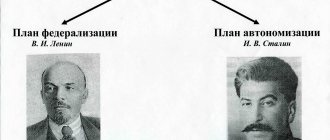Slide 3
Slide description:
Conflict and its structure
Conflict (from Latin conflictus - collision) is a collision of oppositely directed goals, interests, positions, opinions, points of view, views of communication partners.
The main role in the occurrence of conflicts is played by CONFLICTOGENES - words, actions that contribute to the emergence and development of conflict.
•Striving for excellence
•Manifestation of aggression
•Manifestation of selfishness
Techniques of conflict-free communication Prepared by: Poddudinskaya T. - presentation
Techniques of conflict-free communication Prepared by: Poddudinskaya T.
In a dispute, truth is born... Neither a team nor an individual can develop without conflict; the presence of conflicts is an indicator of normal development. (S.I. Mikhailova).
What is conflict ? SCANDAL CAUSES OF CONFLICT, CONFLICT ITSELF
What is conflict ? Conflict Conflict is a collision of oppositely directed, mutually incompatible tendencies in the consciousness of an individual, in interpersonal relationships or interpersonal actions of individuals or groups of people, associated with acute emotional experiences.
Classification of conflicts Conflicts are distinguished according to the time they occur and the degree of reaction of participants to what is happening: fast-flowing conflicts - characterized by great emotional overtones and extreme manifestations of the negative attitude of those in conflict. Sometimes these kinds of conflicts end in difficult and tragic outcomes. Such conflicts are most often based on character traits and mental health of the individual; acute long-term conflicts - arise in cases where contradictions are quite stable, deep, and difficult to reconcile. The conflicting parties control their reactions and actions. Resolving such conflicts is not easy; mild, sluggish conflicts - typical for contradictions that are not very acute, or for clashes in which only one of the parties is active; the second seeks to clearly reveal its position or avoids, as far as possible, open confrontation. Resolving this kind of conflict is difficult; much depends on the initiator of the conflict. mild, fast-flowing conflicts are the most favorable form of conflict, but a conflict can be easily predicted only if there was only one.
Types of conflicts Internal conflict Intergroup conflict Interpersonal conflict Intragroup
The concept of conflict in the educational process It is difficult for a student to comply every day with the rules of conduct in an educational institution and the requirements of teachers during classes and breaks, therefore minor violations of the general order are natural: quarrels, insults, changes in mood, etc. are possible. By correctly responding to the student’s behavior, the teacher takes the situation under his own control and restores order. Haste in judging an action often leads to mistakes. The student is outraged by injustice on the part of the teacher, and then the pedagogical situation turns into a conflict.
Conflict in teaching activities often manifests itself as a teacher’s desire to assert his position and as a student’s protest against unfair punishment, an incorrect assessment of his activities or actions.
There are signals that warn of conflict. Among them: crisis crisis (during a crisis, usual norms of behavior lose their force, there is an unwillingness to solve current problems, the impossibility of contact); misunderstanding incidents misunderstanding and incidents tension tension (This is another signal about the presence of a conflict situation. A state of tension distorts our perception of another person and many of his actions. avoiding contacts, increasing distance, distorting perception); discomfort discomfort (This is an intuitive feeling that something is wrong, although it is difficult to express it in words.). It is pedagogically important to monitor signals indicating the emergence of a conflict.
Causes of conflicts Lack of mutual understanding between teachers and students, caused, first of all, by ignorance of the age-related psychological characteristics of students. Thus, the increased criticality characteristic of adolescence is often perceived by teachers as a negative attitude towards their personality. General climate and organization of work in the teaching staff.
Causes of conflicts Conservatism and stereotyping in the choice of educational methods and means. The teacher, as a rule, evaluates not the individual act of the student, but his personality. This assessment often determines the attitude of other teachers towards the student. The assessment of a student is often based on a subjective perception of his action and little awareness of his motives, personality characteristics, and living conditions in the family. The teacher finds it difficult to analyze the situation and is in a hurry to strictly punish the student.
Causes of conflicts The nature of the relationships that have developed between the teacher and individual students is of no small importance; The personal qualities and non-standard behavior of these students are the cause of constant conflicts with them. Personal qualities of the teacher (irritability, rudeness, vindictiveness, complacency, helplessness); the mood of the teacher when interacting with students; life troubles of the teacher.
Stages of conflicts
Functions of conflicts Positive Negative détente between the conflicting parties large emotional and material costs of participating in the conflict obtaining new information about the opponent dismissal of employees, decrease in discipline, deterioration of the socio-psychological climate in the team unity of the organization’s team when confronting an external enemy the idea of defeated groups as about enemies Stimulating change and development Excessive involvement in the process of conflict interaction to the detriment of work Removing the syndrome of humility in subordinates after the end of the conflict - reducing the degree of cooperation between some employees Diagnosing the capabilities of opponents Difficult restoration of business relationships (trail of conflict).
Tactics of influencing an opponent that everyone should know 1. Tactics of capturing and holding the object of the conflict. 2. Tactics of physical violence (damage). 3. Tactics of psychological violence (damage). 4. Tactics of pressure 5. Tactics of demonstrative actions. 6. Authorization. 7. Tactics of coalitions 8. Tactics of fixing one’s position 9. Tactics of friendliness. 10. Transaction tactics.
Strategies for exiting a conflict The strategy for exiting a conflict is the main line of behavior of a participant at its final stage. K. W. Thomas and R. H. Kilmann developed the basic most acceptable strategies for behavior in a conflict situation. They point out that there are five basic styles of conflict behavior: accommodation, compromise, cooperation, ignoring, rivalry or competition.
Rivalry is about imposing a preferred solution on the other side. Rivalry is justified in the following cases: the proposed solution is clearly constructive; the benefit of the result for the entire group, organization, and not for an individual or microgroup; the importance of the outcome of the struggle for those pursuing this strategy; lack of time to persuade the opponent.
Rivalry This style can be used if: – the outcome of the conflict is very important to you, and you place a big bet on your solution to the problem; – have sufficient power and authority, and it seems obvious that the solution you propose is the best; – feel that you have no other choice and have nothing to lose; – must make an unpopular decision and you have enough authority to choose this step. However, it should be borne in mind that this style, other than a feeling of alienation, cannot cause anything else.
A compromise consists in the desire of the participants to end the conflict with partial concessions. It is characterized by the rejection of some of the previously put forward demands, the willingness to recognize the claims of the other party as partially justified, and the willingness to forgive. Compromise is effective in the following cases: the participant understands that he and the opponent have equal opportunities; the presence of mutually exclusive interests; satisfaction with the temporary solution; threats to lose everything. Today, compromise is the most commonly used strategy for ending conflicts.
Compromise This approach to conflict resolution can be used in the following situations: – both sides have equally convincing arguments; – satisfying your desire is not too important for you; – you may be satisfied with a temporary solution, since there is no time to develop another one, or other approaches to solving the problem turned out to be ineffective.
An open conversation technique is to state that the conflict is disadvantageous to both; propose to end the conflict; admit your mistakes already made in the conflict. They probably exist, and it costs you almost nothing to recognize them; make concessions to your opponent, where possible, on what is not the main thing for you in the conflict. In any conflict you can find a few little things in which it is not worth giving up. You can give in on serious, but not fundamental things; express wishes for concessions required on the part of the opponent. They usually relate to your main interests in the conflict; calmly, without negative emotions, discuss mutual concessions, and, if necessary, adjust them; If you managed to reach an agreement, then somehow record that the conflict has been resolved.
Adaptation or concession is considered as a forced or voluntary refusal to fight and surrender of one’s position. The participant is forced to accept such a strategy by various motives: awareness of his wrongness, the need to maintain good relations with the participant, strong envy from him; insignificance of the problem. In addition, such a way out of the conflict is caused by significant damage received during the struggle, the threat of even more serious negative consequences, the lack of chances for a different outcome, and pressure from a third party.
Adaptation is the most important task - restoring calm and stability, not resolving conflict; – the subject of disagreement is not important to you, or you are not particularly concerned about what happened; – you think that it is better to maintain good relationships with other people than to defend your own point of view; – realize that the truth is not on your side; – feel that you don’t have enough power or a chance to win.
Avoidance or avoidance is an attempt to get out of a conflict at a minimum cost. It differs from a similar strategy of behavior during a conflict in that the participant switches to it after unsuccessful attempts to realize his interests using active strategies. Actually, the conversation is not about resolution, but about the fading of the conflict. Leaving can be a completely constructive response to a protracted conflict. Avoidance is used in the absence of energy and time to resolve a contradiction, the desire to gain time, the presence of difficulties in determining the line of one’s behavior, and the reluctance to solve the problem at all.
Avoiding solving the problem This style can be recommended for use in the following situations: – the source of disagreement is unimportant for you compared to other more important tasks, and therefore you think that it is not worth wasting energy on it; – you know that you cannot or even do not want to resolve the issue in your favor; – you have little power to solve the problem in the way you want; – want to gain time to study the situation and obtain additional information before making any decision; – trying to solve the problem immediately is dangerous, since opening and open discussion of the conflict can only worsen the situation; – you had a difficult day, and solving this problem can bring additional troubles.
Cooperation is considered the most effective strategy for dealing with conflict. It involves opponents focusing on a constructive discussion of the problem, viewing the other side not as an adversary, but as an ally in the search for a solution. Most effective in situations: strong interdependence of participants; the tendency of both to ignore differences in power; the importance of the decision for both parties; open-mindedness of the participants.
Cooperation To resolve conflict, this style can be used in the following situations: – it is necessary to find a common solution if each of the approaches to the problem is important and does not allow compromise solutions; – you have a long-term, strong and interdependent relationship with the other party; – the main goal is to gain joint work experience; – the parties are able to listen to each other and outline the essence of their interests.
Technique “I am statements” 1. Description of the situation that caused the tension: When I see that you... And when this happens... And when I am faced with the fact that The exact name of my feeling in this situation: and I feel... (irritation, helplessness , bitterness, pain, bewilderment, etc.). and I don’t know how to react... and I have a problem Naming the reasons: And because... And due to the fact that...
When resolving a conflict, a stable negative attitude of the parties towards each other remains. It is expressed in a negative opinion about the participant and in negative emotions towards him. To begin to resolve the conflict, it is necessary to soften this negative attitude. It is important to reduce the negative emotions of the opposite party. Among the techniques are such as a positive assessment of some of the opponent’s actions, readiness to bring positions closer together, turning to a third party who is authoritative for the participant, a critical attitude towards oneself, balanced own behavior, etc...
Table Possibility of negotiations depending on the stage of development of the conflict Stages of development of the conflict Possibility of negotiations tension disagreement negotiations are too early, not all components of the conflict have yet been determined rivalry, hostility negotiations are rational aggressiveness negotiations with the participation of a third party violence military actions negotiations are impossible, retaliatory aggressive actions are advisable
Table Possible goals and results of participation in negotiations Statement of goals Possible results Reflect our interests to the maximum extent The most desirable results for us Take our interests into account Acceptable results Practically do not take into account our interests Unacceptable results Infringe on our interests Completely unacceptable results
General recommendations for resolving a conflict situation can be summarized as follows: Recognize the existence of a conflict, that is, recognize the presence of opposing goals and methods among opponents, identify these participants themselves. In practice, these issues are not so easy to resolve; it can be quite difficult to admit and say out loud that you are in a state of conflict with an employee on some issue. Sometimes a conflict has existed for a long time, people suffer, but there is no open recognition of it, everyone chooses their own form of behavior and influence on the other, but there is no joint discussion and way out of the current situation.
General recommendations for resolving a conflict situation can be summarized as follows: Determine the possibility of negotiations. After recognizing the existence of a conflict and the impossibility of resolving it right away, it is advisable to agree on the possibility of holding negotiations and clarify what kind of negotiations: with or without a mediator and who can be a mediator that is equally satisfactory for both parties. Agree on the negotiation procedure. Determine where, when and how negotiations will begin, i.e. stipulate the timing, place, procedure for conducting negotiations, and the start time of joint activities. Identify the range of issues that constitute the subject of the conflict. The main problem is to define in shared terms what is in conflict and what is not. Already at this stage, joint approaches to the problem are developed, the positions of the parties are identified, the points of greatest disagreement and points of possible convergence of positions are determined.
General recommendations for resolving a conflict situation can be summarized as follows: Develop solutions. The parties, when working together, offer several solution options with cost calculations for each of them, taking into account the possible consequences. Make an agreed decision. After considering a number of possible options, during mutual discussion and provided that the parties come to an agreement, it is advisable to present this general decision in writing: a communiqué, resolution, cooperation agreement, etc. In particularly complex or critical cases, written documents are drawn up after each stage of negotiations. Implement the decision made in practice. If the process of joint action ends only with the adoption of a well-developed and agreed upon decision, and then nothing happens or changes, then this situation can be the detonator of other, stronger and longer-lasting conflicts. The reasons that caused the first conflict have not disappeared, but have only been strengthened by unfulfilled promises. Repeated negotiations will be much more difficult.
Thank you for your attention !
Slide 4
Slide description:
Types of conflicts
Attention!
If you need help writing a paper, we recommend turning to professionals. More than 70,000 authors are ready to help you right now. Free adjustments and improvements. Find out the cost of your work
Free estimate
+1
Size: 2.06M
Downloads: 49
01/08/14 at 13:12 Author: bella333
Liked? Click on the button below. It's not difficult for you
, and we
are pleased
).
To download Presentations for free at maximum speed, register or log in to the site.
Important! All Presentations presented for free downloading are intended to create a plan or basis for your own scientific works.
Friends! You have a unique opportunity to help students just like you! If our site helped you find the job you need, then you certainly understand how the job you add can make the work of others easier.
Add a job
If the Presentation, in your opinion, is of poor quality, or you have already seen this work, please let us know.
Similar works
- Conflicts in the personnel management system
- Conflict resolution in business communication
- Conflict regulation in the activities of an organization (using the example of JSC Tatsve)
- Intragroup and intergroup conflicts in the organization
- Conflicts and ways to overcome them
- Conflict management in an organization
- Concept and types of conflict
- Psychodiagnostics of conflicts in business communication
- Conflicts and ways to overcome them
- Methods for preventing and resolving conflicts (Option 18)
- Management Test Option 9
- Conflicts and ways to overcome them
- Causes of conflicts and ways to resolve them (Option 16)
- Conflict resolution in business communication
- Conflict in business communication: structure, functions, ways of resolution
- Conflicts in the organization
- Structure and typology of conflicts
- Conflicts and ways to overcome them
- Major conflicts in modern Russia
- Conflicts and ways to overcome them
The working material is focused on using the textbook by L.N. Bogolyubova, N.F. Vinogradova, N.I. Goretskaya and others. Social science. 6th grade educational for general education institutions - Education, 2013.
Topic: “Conflicts in Interpersonal Relationships.”
Lesson type: combined lesson.
Goals:
- contribute to the formation of ideas about the occurrence of interpersonal conflicts and ways to resolve them,
- develop the ability to analyze, draw conclusions, evaluate specific situations, answer questions, express one’s point of view, create conditions for reflection and improve students’ own communication skills: the ability to listen and hear their classmates, the ability to enter into dialogue and participate in collective discussion, the ability to accurately express one's thoughts,
- develop a culture of relationships in the group,
- correction of thinking based on establishing dependencies between objects.
Equipment: textbook, presentation, worksheets with tasks, recording of the cartoons “Contact” and “Fedorino’s Grief”.
Basic concepts: conflict, interpersonal conflict, incident, mediator.
During the classes:
I. Organization of the beginning of the lesson.
Plan:
- Let's name the words.
- We will complete the tasks.
- We will work with the textbook.
- We will answer questions.
- We will take notes in a notebook.
Speech warm-up.
II. Checking what you've learned before
Card
III. Setting the goals and objectives of the lesson. Motivation for students' learning activities.
Exercise . Arrange the shapes according to the pattern and find out the topic of the lesson.
- What is the topic of the lesson? (Conflict)
- What do you think we will talk about today, what are the goals of our lesson.
Plan:
- Causes of conflicts in interpersonal relationships.
- Options for behavior in a conflict situation.
- How not to lose in a conflict.
Goals:
Let's study... Let's find out... Let's check...
With the help of the words “helpers”, children formulate the goals of the lesson.
IV. Assimilation of new knowledge.
1. REASONS FOR CONFLICTS IN INTERPERSONAL RELATIONSHIPS.
- A dialogue is organized with students on the following questions:
– What rules of communication do you know?
– What are the consequences of non-compliance with these rules?
- Discussion of the “Let’s discuss it together” section, p. 76
- Read the situation in which the boy Andrei found himself.
- Parable of Patience
Parable of Patience
At the appointed time, the donkey came to water.
But the ducks on the pond were so loud and playful, flapping their wings, that they muddied all the water.
Although the donkey was tormented by unbearable thirst, he did not drink and, moving aside, began to wait patiently.
Finally the ducks calmed down and, coming ashore, walked away. The donkey approached the water again, but it was still muddy. And he walked away again with his head down.
- Mom, why doesn’t he drink? – asked the curious frog, interested in the donkey’s behavior. “He’s come to the pond twice now and left with nothing.”
“And all because,” answered the mother frog, “that the donkey would rather die of thirst than touch dirty water.” He will wait patiently until the water clears and becomes clear.
- Oh, how stubborn he is!
“No, son, he is not so much stubborn as he is patient,” explained the frog. – The donkey is ready to endure all the hardships and sorrows. And he is called stubborn by everyone who himself lacks endurance and patience.
- A dialogue is organized with students on the following questions:
- What is the moral of this parable?
- And if a person lacks patience when communicating with others, what can happen?
- If rules are violated during communication, conflict arises.
(Slide)
CONFLICT is a clash .
(Write in notebook)
- Name 5 synonyms for this concept.
(Slide)
INTERPERSONAL CONFLICT is a clash between several participants due to differences in interests, opinions, and views.
(Write in notebook)
Task 1. In its development, a conflict usually goes through five successive stages. Read the textbook material on page 76 and name the stages of development of the conflict.
Task 2. Read the textbook material on page 77 and find the causes of conflicts.
The most common causes of conflicts are various barriers:
- barrier of someone else's desire;
- semantic barrier;
- emotional barrier;
- moral barrier.
2. OPTIONS FOR BEHAVIOR IN A CONFLICT SITUATION
- There are certain types of behavior in a conflict situation that help resolve the conflict even before it enters the open stage. These are cooperation, compromise, avoidance and accommodation. (Slide)
Task 3. Read the textbook material on pp. 79-80 and determine the type of behavior of the participants in the conflict.
(Slide)
Teacher's story
(Slide)
INCIDENT is an incident, an incident, a misunderstanding, something that happened, a collision.
INCIDENT = CONFLICT
(Write in notebook)
Completing tasks under the heading “In the classroom and at home”, p. 82–83, no. 1.
3. HOW NOT TO LOSE IN A CONFLICT.
Even the most protracted conflict ends sooner or later. And then comes the final stage - conflict resolution. It can be complete or partial. As in the conflict situation preceding the development of the incident, at the final stage there are also four possible outcomes: submission, compromise, interruption of conflict actions, integration.
Exercise. Read the textbook material on pp. 80-81 and identify options for ending the conflict.
Situation
Your best friend did not come to the stadium, because of this the team lost an important match. What do you say to a friend you're upset with? How to avoid a quarrel over this offense?
Working with the rubric “Learning to behave in a conflict situation,” p. 83
Introduces the rules of communication in a conflict situation.
Teacher's story.
When it is still difficult to understand another person, you can turn to a neutral intermediary.
A MEDIATOR is an outsider who is not involved in the conflict.
The practice of mediation is widely used in conflicts between states, but participants in interpersonal conflicts turn to it much less often.
V. Consolidation of knowledge.
Task 1. Pronounce the words, placing emphasis.
Conflict, interpersonal conflict, incident, mediator.
Task 2. Analyze the conflict. (Recording of the cartoons “Contact” and “Fedorino’s grief”).
Analysis plan:
- Participants in the conflict.
- Cause of the conflict.
- A way to resolve conflict.
- Assessing the method of conflict resolution.
Task 3. Try to find a way out of the situation.
Task 4. Before you is a series of words, to varying degrees related to the concept of “conflict”. Arrange (in your notebook) all the words on the scale so that the words closest to the word “conflict” are those that more closely correspond to this concept. Keep in mind that multiple words can fit in one position.
Dispute, skirmish, contention, squabble, clash, feud, scolding, quarrel, battle, disagreement, discussion, collapse, scandal, trouble, disagreement, quarrel, discord, fight, squabble, dispute, brawl.
When summing up the results, the word in 1st place receives 10 points, in 2nd place - 9 points, and so on until the 10th position - 1 point.
In your class, count which word gets the maximum score.
Frontal survey.
- What is conflict"?
- What is “interpersonal conflict”?
- What is an "incident"?
- Who is a “mediator”?
- Name the main stages of conflict development.
- What types of behavior exist in conflict?
- Which one do you think is the best? Why?
- How can the conflict end?
VI. Generalization.
VII. Summarizing. Reflection.
- Reflection.
- Assessing student work. Making marks.
- Homework. Learn the notes in your notebook.
You can download the presentation for the lesson here.
You can download the lesson notes here.







